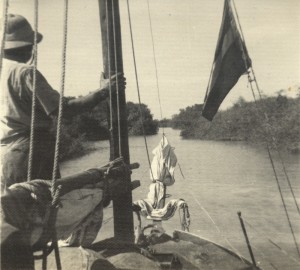The four year journey
In the summer of 1947, Ploks left on an adventure-filled journey with his wife and son. The Ploks family spent nearly four years on their journey with the home-made boat, Biscaya. During the trip they sailed on rivers, canals, seas and finally crossed the Atlantic Ocean. All of Ploks’ knowledge about boating and navigation was self-taught, learnt mostly during the trip itself. Haralds Ploks had learnt to read coordinates and distances.
The journey began in Mannheim, Germany, when the Biscaya was lowered into the waters of the Rhine. Their route led them on to Emden in northern Germany. To get onto the open seas and out of Germany, they had to engage in trickery again, as the Biscaya only had the right to sail in rivers and canals. By finding and convincing influential people at the port, the Ploks were able to get away and headed to Holland and then further to Belgium and France. At the Port of Calais in France, the Ploks family decided to steer to London to visit Latvia’s Ambassador Zariņš to get passports. However, the sea was covered in thick fog and conditions were very dangerous, as the little vessel could easily be overturned by a larger one. The Biscaya headed back to Calais and the Ploks’ decided to cross France from north to south along the rivers and canals. Their journey later took them over the Mediterranean to Italy and North Africa. For a long time, the Biscaya sailed along the African coast stopping at ports in various exotic lands. Finally, the Ploks family decided to head for Brazil. This trip over the Atlantic Ocean began at the port of Conakry and ended after 14 days at Fortaleza. After their long journey on the world’s waters, the Ploks family decided to settle in Brazil, and the legendary Biscaya was sold to a local farmer. The last port where the Ploks family stopped with the Biscaya was Belem do Para.
Throughout the journey, the Ploks family lived from the income they gained from preparing and selling souvenirs. In his youth, Kārlis Ploks had learned sculpting at a gypsum manufacturing factory in Rīga. He used this knowledge during the journey with the Biscaya to create wall plaques from plaster of paris, embossed with images of various people and animals. The plaques were sold from port to port, and with the money earned, the Ploks family could continue their trip. Haralds Ploks remembers:
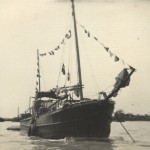
The boat "Biscaya". The photo shows flags sewn by Alma Ploks, around 1949
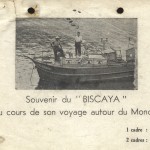
Advertising leaflet with an offer to buy souvenirs
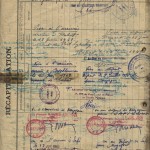
Page from the ship's log of the "Biscaya"

